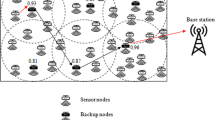Abstract
In this paper, we develop the cost function of the path management method for data delivery in large-scale heterogeneous sensor network. Usually, the most conventional methods determine the optimal coefficients in the cost function, without considering the node surrounding environments, such as the wireless propagation environment or the topological environment. Due to this reason, there is the limitation to improve the performance of path management, such as data delivery ratio and delay of data delivery. To solve this problem, we derive a new cost function using the concept of partially connected neural network (PCNN) that is modeled according to the input types whether inputs are correlated or uncorrelated. In our application, we assume that all inputs of the cost function are uncorrelated. Thus, we connect all inputs to the hidden layer of the PCNN in an uncoupled way. We also propose the training technique for finding the optimal weights in the PCNN. Our PCNN is trained to maximize the packet transmission success ratio. In the experimental section, we show that our PCNN method outperforms other conventional methods in terms of the quality of data delivery, such as data delivery ratio and delay of data delivery.








Similar content being viewed by others
References
Kulkarni RV, Förster A, Venayagamoorthy GK (2011) Computational intelligence in wireless sensor networks: a survey. IEEE Commun Surv Tutor 13(1):68–96
Culler D, Estrin D, Srivastava M (2004) Overview of sensor networks. IEEE Comput 37(8):41–49
Romer K, Mattern F (2004) The design space of wireless sensor networks. IEEE Wirel Commun 11(6):54–61
Al-Karaki JN, Kamal AE (2004) Routing techniques in wireless sensor networks: a survey. IEEE Wirel Commun 11(6):6–28
Niculescu D (2005) Communication paradigms for sensor net-works. IEEE Commun Mag 43(3):116–122
Song WZ, Huang R, Xu M, Shirazi BA, Lahusen R (2010) Design and deployment of sensor network for real-time high-fidelity volcano monitoring. IEEE Trans Parallel Distrib Syst 21(11):1674–1685
Sankarasubramaniam Y, Akan OB, Akyildiz IF (2003) ESRT: Event-to-sink reliable transport in wireless sensor networks. In: Proceedings of ACM annual international conference on mobile computing and networking, MOBICOM2003, Annapolis, pp 177–188
Chen H, Tse CK, Feng J (2009) Minimizing effective energy consumption in multi-cluster sensor networks for source extraction. IEEE Trans Wirel Commun 8(3):1480–1489
Kuhn F, Wattenhofer R, Zollinger A (2008) An algorithmic approach to geographic routing in ad hoc and sensor networks. IEEE Trans Netw 16(1):51–62
Haykin S (1998) Neural networks: a comprehensive foundation. Prentice-Hall, Upper Saddle River
Heinzelman WR, Chandrakasan A, Balakrishnan H (2000) Energy-efficient communication protocol for wireless microsensor networks. In: Proceedings of the Hawaii international conference on system science, pp 1–10
Lindsey S, Raghavendra CS (2002) Pegasis: power-efficient gathering in sensor information systems. In: Proceedings of IEEE aerospace conference
De Couto D, Aguayo D, Bicket J, Morris R (2005) High-throughput path metric for multi-hop wireless routing. ACM Wirel Netw 11(4):419–434
Draves R, Padhye J, Zill B (2004) Routing in multi-radio, multi-hop wireless mesh networks. In: Proceedings of ACM annual international conference on mobile computing and networking (MOBICOM), Philadelphia, pp 114–128
Lindsey S, Raghavendra C (2002) PEGASIS: power-efficient gathering in sensor information systems. In: Proceedings of IEEE aerospace conference, pp 1125–1130
Rodoplu V, Meng TH (1999) Minimum energy mobile wireless networks. IEEE J Sel Areas Commun 17(8):1333–1344
Shah R, Rabaey J (2002) Energy aware routing for low energy ad hoc sensor networks. In: Proceedings of IEEE wireless communications & networking conference (WCNC), Orlando, pp 350–355
Younis M, Youssef M, Arisha K (2002) Energy-aware routing in cluster-based sensor networks. In: Proceedings of IEEE/ACM international symposium on modeling, analysis and simulation of computer and telecommunication systems (MASCOTS), pp 129–136
Youssef M, Younis M, Arisha K (2002) A constrained shortest-path energy-aware routing algorithm for wireless sensor networks. In: Proceedings of IEEE wireless communications & networking conference (WCNC), Orlando, pp 749–799
Szymanski BK, Chen BG (2008) Computing with time: from neural networks to sensor networks. Comput J Br Comput Soc 51(4):511–522
Zhao W, Liu D, Jiang Y (2009) Distributed neural network routing algorithm based on global information of wireless sensor network. In: Proceedings of IEEE international conference on communications and mobile computing (CMC), pp 552–555
Toumpis S, Goldsmith AJ (2003) Capacity regions for wireless ad hoc networks. IEEE Trans Wirel Commun 2(4):736–748
Rayanchu S, Mishra A, Agrawal D, Saha S, Banerjee S (2008) Diagnosing wireless packet losses in 802.11: separating collision from weak signal. In: Proceedings of IEEE conference on computer communications (INFOCOM), pp 735–743
Kang S, Isik C (2005) Partially connected feedforward neural networks structured by input types. IEEE Trans Neural Netw 16(1):175–184
The network simulator, ns-2. Available on-line at http://www.isi.edu/nsnam/ns
Rappaport TS (1996) Wireless communications, principles and practice. Prentice Hall, Upper Saddle River
IEEE Std. 802.15.4 (2003) Wireless medium access control (MAC) and physical layer (PHY) specifications for lower-rate wireless personal area networks (LR-WPANs)
Acknowledgment
This work was supported by an Inha University Research Grant.
Author information
Authors and Affiliations
Corresponding author
Rights and permissions
About this article
Cite this article
Lim, Y., Kang, S. Path management method using partially connected neural network in large-scale heterogeneous sensor network. Neural Comput & Applic 21, 1931–1936 (2012). https://doi.org/10.1007/s00521-011-0664-9
Received:
Accepted:
Published:
Issue Date:
DOI: https://doi.org/10.1007/s00521-011-0664-9




